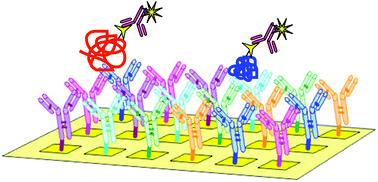A novel antibody microarray format using non-covalent antibody immobilization with chemiluminescent detection
Abstract
To date, protein and antibody microarrays have been used in reverse-phase and sandwich-based methods in order to detect known proteins such as biomarkers in samples. Our group developed “libraries” of antibodies against unknown proteins, referred to as mKIAA proteins, and we attempted to discover candidate novel biomarkers by protein expression profiling.
To profile mKIAA protein expression using these antibodies, we established an antibody microarray system using chemiluminescent detection. A number of techniques for protein–antibody microarrays have been reported; however, no entirely suitable protocol for crude protein samples has been established. To address this issue, we immobilized purified antibodies on hydrophilic surface polymer slides (Maxisorp™, Nunc). Although our system is based on the direct labeling of crude protein samples, we achieved sufficient sensitivity (detection limit: 50 pg mL–1) and low backgrounds. This sensitivity is on a level with the sandwich


 Please wait while we load your content...
Please wait while we load your content...